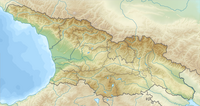 | ||
Wani, ვანი, Vani Archaeological Museum in Wani | ||
| Region (Mchare) | Imereti | |
|---|---|---|
| Residents | 3.744 (2014) | |
| height | 60 m | |
| no tourist info on Wikidata: | ||
| location | ||
| ||
Wani (also: Vani, Georgian: ვანი) is the capital of the administrative district of the same name (Raioni) in the region Imereti, about 30 km south of Samtredia. Wani is famous for its rock tombs, richly furnished with gold finds, which were part of a large urban settlement of antiquity. The former capital of Colchis is believed to be in Wani.
background
Wani is famous for its rock tombs richly furnished with gold finds. Objects were washed ashore in fields as early as the 19th century. From 1896 Taqaishvili was systematically excavated by Ekwtime, but it was not until 1960 that large-scale excavation campaigns began.
A temple city with richly decorated rock tombs with additions made of precious metal from the 8th – 4th centuries was found. Century BC Above all, the gold work is evidence of a high culture, the style and execution only with works from Persia of the 4th century BC. Are to be compared. They are independent of Scythian, Greek or other known works so early on. Only in the 4th century BC The influence of the Hellenistic culture increases.
Current knowledge is based on four historical settlement phases in the city of Wani. The earliest is in the 8th and 7th centuries BC. A 90 m² sacrificial place on the central terrace suggests that the place was already an important place of worship back then. The finds testify to lively sacrificial activity: clay miniature altars, various animal idols, numerous animal bones, smashed clay dishes, ashes scattered everywhere. The second period from the 6th to the first half of the 4th century BC BC is the time of the heyday of the state of Colchis. In addition to the high-quality local metalworking, Greek imported ceramics are now also appearing.
From the middle of the 4th century to the 3rd century BC The third phase of settlement extends to Wani. It is characterized by extensive renovations, especially in stone architecture. In the 3rd to 1st century BC BC Wani becomes a typical temple town of a provincial Asia Minor. During this period major structural changes take place, the old systems are razed and new ones are built.
In the 1st century the city became with the attack of the Pontic king Pharnakes II. On Colchis in the year 49 BC. Destroyed for the first time. The second event of destruction depends on the incursion of King Mithridates VII around 47 BC. Together. Then stagnation set in, in the Middle Ages the place was of little importance.
getting there
By plane
The Kutaisi airport is 30 km from Wani.
By train
Next train station, where express trains also stop: Samtredia
By bus
The Wani bus station is in the center, at the east of the two roundabouts. The usual marshrutkas drive to the neighboring cities.
In the street
The well-developed regional road შ 13 (Dapnari-Baghdati) leads through the middle of the city.
mobility
The archaeological museum is located on a hill about 2 km outside the center. If you don't want to walk, you can take a taxi.
You can take taxis or marshrutkas to the surrounding area if you don't have your own car.
Tourist Attractions
- Wanis Nakalakari. The excavation site.
- Wani Archaeological Museum. Unfortunately closed for renovation at the moment.
Surroundings:
- Galaktion and Tizian Tabidse House-Museum. Tel.: 995 593 560506. In the family home of the two poets in the village of Tktschwischi, personal items as well as sculptures and paintings by other Georgian artists are shown.Open: Tue - Sun 10 a.m. - 5 p.m.Price: Entry 1 lari.
activities
shop
kitchen
nightlife
accommodation
health
Practical advice
trips
literature
Web links
- http://www.vani.org.ge - Wani official website


